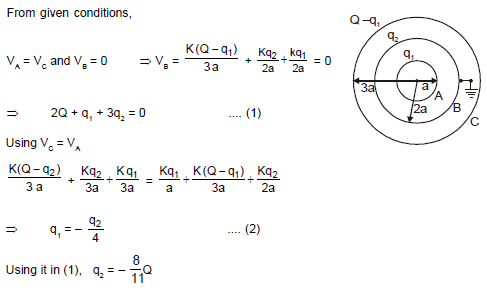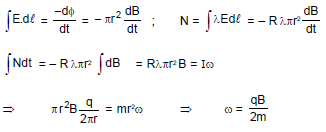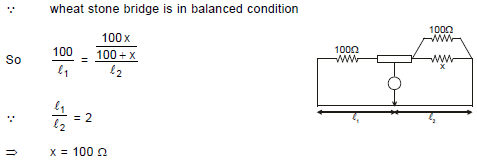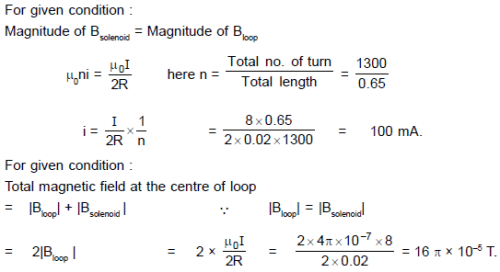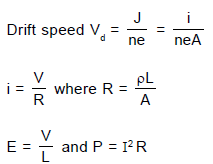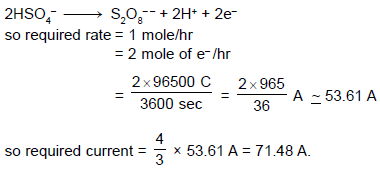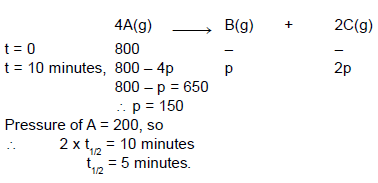JEE Advanced Test- 8 - JEE MCQ
30 Questions MCQ Test - JEE Advanced Test- 8
When a galvanometer is shunted with a 4 resistance, the deflection is reduced to one-fifth. If the galvanometer is further shunted with a 2
resistance, the deflection is reduced to one-fifth. If the galvanometer is further shunted with a 2 wire, the further reduction in the deflection will be (the main current remains the same).
wire, the further reduction in the deflection will be (the main current remains the same).
An inductor (xL = 2 ) a capacitor (xC = 8
) a capacitor (xC = 8 ) and a resistance (8
) and a resistance (8 ) is connected in series with an A.C. source. The voltage output of A.C. source is given by v = 10 cos 100πt. The instantaneous potential difference between A and B, when it is half of the voltage output from source at that instant will be :
) is connected in series with an A.C. source. The voltage output of A.C. source is given by v = 10 cos 100πt. The instantaneous potential difference between A and B, when it is half of the voltage output from source at that instant will be :

Figure shows a system of three concentric metal shells A, B and C with radii a, 2a and 3a respectively. Shell B is earthed and shell C is given a charge Q. Now if shell C is connected to shell A, then the final charge on the shell B, is equal to :
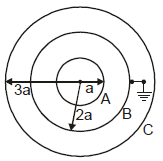

A ring of mass m, radius r having charge q uniformly distributed over it and free to rotate about its own axis is placed in a region having a magnetic field B parallel to its axis. If the magnetic field is suddenly switched off, the angular velocity acquired by the ring is :
Four infinite ladder network containing identical resistances of R each, are combined as shown in figure. The equivalent resistance between A and B is RAB and between A and C is RAC. Then the value of is :
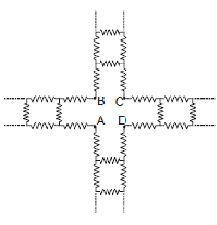
Two small balls, each having equal positive charge Q are suspended by two insulating strings of equal length L from a hook fixed to a stand. If the whole set-up is transferred to a satellite in orbit around the earth, the tension in equilibrium in each string is equal to

In a practical wheat stone bridge circuit as shown, when one more resistance of 100 ? is connected in parallel with unknown resistance ' x ', then ratio l1/l2 becomes '2'. l1 is balance length. AB is a uniform wire. Then value of ' x ' must be :
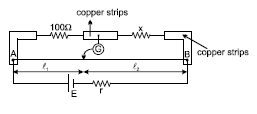
Loop A of radius (r << R) moves towards loop B with a constant velocity V in such a way that their planes are always parallel. What is the distance between the two loops (x) when the induced emf in loop A is maximum
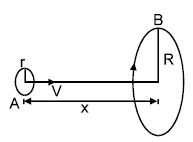
The figure shows, a graph of the current in a discharging circuit of a capacitor through a resistor of resistance 10.

A single circular loop of wire with radius 0.02 m carries a current of 8.0 A. It is placed at the centre of a solenoid that has length 0.65 m, radius 0.080 m and 1300 turns.
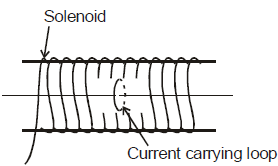
In front of an earthed conductor a point charge + q is placed as shown in figure :
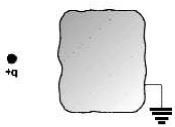
In the figure shown the key is switched on at t = 0. Let I1 and I2 be the currents through inductors having self inductances L1 & L2 at any time t respectively. The magnetic energy stored in the inductors 1 and 2 be U1 and U2. Then at any instant of time is :
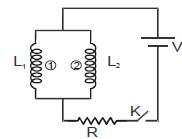
Statement – 1
Four point charges q1, q2, q3 and q4 are as shown in figure. The flux over the shown Gaussian surface depends only on charges q1 and q2.
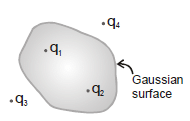
Statement – 2
Electric field at all points on Gaussian surface depends only on charges q1 and q2.
Statement 1 : A direct uniformly distributed current flows through a solid long metallic cylinder along its length. It produces magnetic field only outside the cylinder .
Statement 2 : A thin long cylindrical tube carrying uniformly distributed current along its length does not produce a magnetic field inside it. Moreover, a solid cylinder can be supposed to be made up of many thin cylindrical tubes.
Statement–1 : Magnitude of potential difference across the terminals of a non-ideal battery in a circuit cannot be greater than its emf.
Statement–2 : When a current of magnitude I is passing through a battery of emf E and internal resistance r as shown, the magnitude of potential difference (V) across the battery is given by V = E– I r
Statement–1 : No electric current will be present within a region having uniform and constant magnetic field.
Statement–2 : Within a region of uniform and constant magnetic field , the path integral of magnetic field
along any closed path is zero. Hence from Ampere circuital law
(where the given terms have usual meaning), no current can be present within a region having uniform and constant magnetic field.
In the circuit given below, both batteries are ideal. EMF E1 of battery 1 has a fixed value, but emf E2 of battery 2 can be varied between 1.0 V and 10.0 V. The graph gives the currents through the two batteries as a function of E2, but are not marked as which plot corresponds to which battery. But for both plots, current is assumed to be negative when the direction of the current through the battery is opposite the direction of that battery's emf. (Direction of emf is from negative to positive)
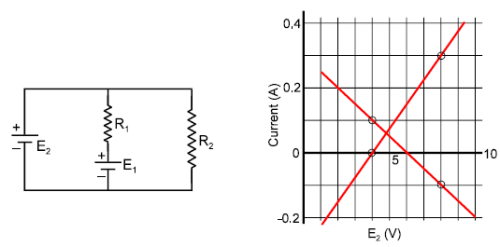
Q. The value of emf E1 is :
In the circuit given below, both batteries are ideal. EMF E1 of battery 1 has a fixed value, but emf E2 of battery 2 can be varied between 1.0 V and 10.0 V. The graph gives the currents through the two batteries as a function of E2, but are not marked as which plot corresponds to which battery. But for both plots, current is assumed to be negative when the direction of the current through the battery is opposite the direction of that battery's emf. (Direction of emf is from negative to positive)

Q. The resistance R1 has value :
In the circuit given below, both batteries are ideal. EMF E1 of battery 1 has a fixed value, but emf E2 of battery 2 can be varied between 1.0 V and 10.0 V. The graph gives the currents through the two batteries as a function of E2, but are not marked as which plot corresponds to which battery. But for both plots, current is assumed to be negative when the direction of the current through the battery is opposite the direction of that battery's emf. (Direction of emf is from negative to positive)

Q. The resistance R2 is equal to :
Curves in the graph shown give, as functions of radial distance r (from the axis), the magnitude B of the magnetic field (due to individual wire) inside and outside four long wires a, b, c and d, carrying currents that are uniformly distributed across the cross sections of the wires. Overlapping portions of the plots are indicated by double labels. All curves start from the origin.
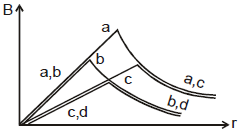
Q. Which wire has the greatest radius ?
Curves in the graph shown give, as functions of radial distance r (from the axis), the magnitude B of the magnetic field (due to individual wire) inside and outside four long wires a, b, c and d, carrying currents that are uniformly distributed across the cross sections of the wires. Overlapping portions of the plots are indicated by double labels. All curves start from the origin.

Q. Which wire has the greatest magnitude of the magnetic field on the surface ?
Curves in the graph shown give, as functions of radial distance r (from the axis), the magnitude B of the magnetic field (due to individual wire) inside and outside four long wires a, b, c and d, carrying currents that are uniformly distributed across the cross sections of the wires. Overlapping portions of the plots are indicated by double labels. All curves start from the origin.

Q. The current density in wire a is
Match the following :
The following table gives the lengths of four copper rods at the same temperature, their diameters, and the potential differences between their ends.

Correctly match the physical quantities mentioned in the left column with the rods as marked.
(A) Rod 1 (p) Greatest Drift speed of the electrons.
(B) Rod 2 (q) Greatest Current
(C) Rod 3 (r) Second greatest current
(D) Rod 4 (s) Greatest Electric field
(t) greatest resistance
A square loop of uniform conducting wire is as shown in figure. A current-I ( in amperes) enters the loop from one end and exits the loop from opposite end as shown in figure. The length of one side of square loop is l metre. The wire has uniform cross section area and uniform linear mass density. In four situations of column-I, the loop is subjected to four different uniform and constant magnetic field. Under the conditions of column-I, match the column-I with corresponding results of column-II ( Bo in column I is a positive nonzero constant)
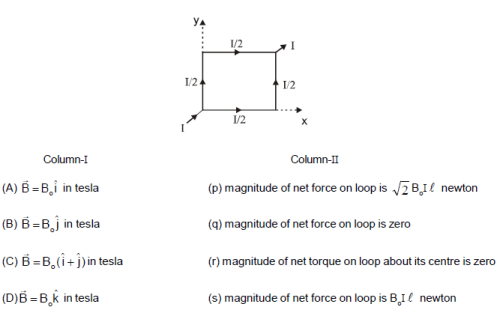
In an f.c.c. crystal, which of the following shaded planes contains the following type of arrangement of atoms?

In an f.c.c. unit cell, atoms are numbered as shown below. The atoms not touching each other are :
(Atom numbered 3 is face centre of front face).

Electrolysis of a solution of HSO4- ions produces S2O8– –. Assuming 75% current efficiency, what current should be employed to achieve a production rate of 1 mole of S2O8- - per hour ?
You are given the following cell at 298 K, = – 0.76 V. Which of the following amounts of NaOH (equivalent weight = 40) will just make the pH of cathodic compartment to be equal to 7.0 :
For the following parallel chain reaction

what will be that value of overall half-life of A in minutes?
Decomposition of A follows first order kinetics by the following equation.
4A(g) ——> B(g) + 2C(g)
If initially, total pressure was 800 mm of Hg and after 10 minutes it is found to be 650 mm of Hg. What is half-life of A ? (Assume only A is present initially)




